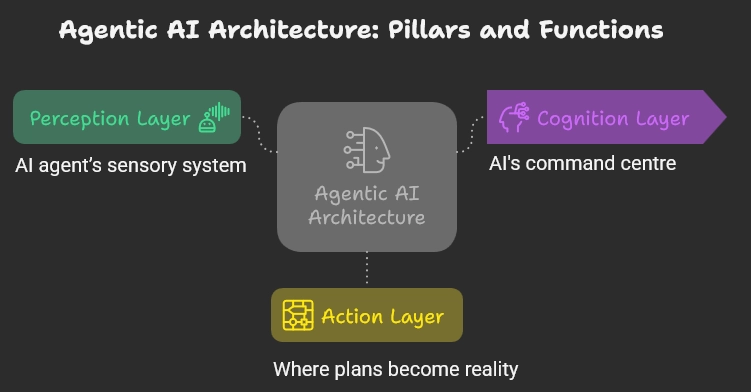Agentic Architecture in AI: Layers, Types, Diagrams & Examples

Agentic AI architecture refers to the approach of building AI systems that can think and act independently, rather than merely following scripts. It operates through three core layers: perception (understanding what is happening), cognition (deciding what to do), and action (actually doing it). You have the option to create a single-agent system or a multi-agent network, depending on what you're trying to accomplish. The good news is that there are plenty of tools and frameworks out there to help you build these systems, so you can pick the approach that fits your specific needs and goals.
Are you constantly chasing leads, manually tracking conversations, or struggling to move prospects through the pipeline? W
hat if you didn’t have to babysit every step, and your system could do the thinking for you? That’s where Agentic AI steps in.
Unlike traditional automation, agentic systems don’t just follow rules—rather, they understand your goals, plan toward them, and solve challenges on the fly. You can think of them as building an AI teammate that acts with purpose, makes wise decisions, and keeps on working till it delivers what you want.
But how do these systems actually work? What gives them that autonomy, and how do you design one to fit your needs?
That’s where Agentic Design Patterns come in. These are proven structural templates and interaction flows that guide how your AI agents perceive their environment, make decisions, and coordinate actions. Just like design patterns in software development, agentic patterns help you build intelligent systems that are reliable, adaptable, and efficient—whether you’re designing a single autonomous agent or an entire swarm of them.
We’re here to walk you through that. Keep reading to know what agentic architecture really means, what components make it tick, the types of setups you can build, and how to get started creating your own.
What is agentic architecture?
Agentic architecture is what gives AI systems the ability to think and act on their own. It moves AI from being reactive tools that respond only when told what to do to proactive agents that can figure out what needs to be done and take initiative.
Inspired by human cognitive abilities, agentic architecture in AI brings together components that allow it to plan, reason, and learn from experience.
At its core, agentic behaviour is defined by three qualities:
-
Autonomy: The ability to make decisions independently
-
Adaptability: The capacity to adjust to new or unexpected scenarios
-
Goal-orientation: A focus on achieving specific outcomes through planning and action
By integrating these traits, agentic architecture allows AI to operate more like a strategic partner than a programmable tool. It sets the stage for scalable, intelligent automation across business workflows, product ecosystems, and customer-facing services.
The three pillars of agentic AI: Perception, cognition, and action
For agentic architecture to work effectively, several critical components must function together seamlessly, enabling autonomy.

1. Perception layer
The perception layer functions as the AI agent’s sensory system. It's constantly gathering data from the environment and converting it into something the system can actually work with. This information becomes the foundation for all the reasoning and planning that follows.
By interpreting context in real-time, the perception module helps the AI build a clear understanding of its surroundings. This enables agentic systems to respond intelligently rather than react blindly to triggers.
2. Cognition layer
The cognition layer is where the real thinking happens. This is the AI's command centre where it sets goals, figures out plans, makes decisions, and keeps track of its internal state.
It takes everything the perception layer feeds it and works out the best move based on what it's trying to accomplish. All the heavy cognitive lifting happens here: memory management, logical reasoning, evaluating options, and reflecting on outcomes. This allows the system to stay flexible and adjust its approach as conditions change.
3. Action layer
The action layer is where plans become reality. It takes the decisions from the cognition module and actually executes them in the real world, whether that's through physical hardware or digital connections.
This could mean anything from making an API call to moving a robot's arm or starting up a conversation. The action module connects internal planning with external outcomes, ensuring everything the agent does remains aligned with its objectives.
The types of agentic architecture in AI: Single-agent, multi-agent, and hybrid
The way you design an agentic system makes a real difference in how well it works when you put it into practice. From simple single-agent models to complex multi-agent networks, each one handles different levels of complexity and coordination.
The key is matching your choice to what you're trying to achieve, how much you need the system to scale, and how unpredictable your environment tends to be.
1. Single-agent
In this setup, one agent is responsible for the full cycle of perception, reasoning, and action. It processes input, makes decisions based on goals, and interacts with its environment independently. All memory, state, and control logic are housed within this one agent.
| Strengths | Weaknesses |
|---|---|
| Simpler to design, test, and deploy | Limited scalability and specialisation |
| Faster to prototype and iterate | Becomes brittle under high complexity |
| Lower resource overhead compared to distributed setups | Harder to isolate failures or extend capabilities modularly |
Use cases:
-
Virtual assistants that handle one user or workflow
-
Autonomous bots for single-domain tasks like summarisation, retrieval, or monitoring
-
Proof-of-concept systems to test agentic logic before scaling
2. Multi-agent
This architecture uses multiple agents, each with a specific role or function. Agents can communicate, share goals, delegate tasks, and coordinate actions across the system. Some may act as planners or supervisors, while others handle execution or evaluation.
| Strengths | Weaknesses |
|---|---|
| Enables specialisation and role-based collaboration | Higher design complexity and coordination overhead |
| Scales well across distributed environments | Requires reliable communication and conflict resolution mechanisms |
| Resilient to failure through redundancy or fallback agents | Debugging can be challenging in tightly coupled workflows |
Use cases:
-
Enterprise automation tools for departments or workflows
-
Agent teams in research, coding, or content generation using tools like AutoGen
-
Systems that need dynamic delegation and real-time cooperation
Read our guide on multi-agent systems in AI to implement them for your business
3. Hybrid
Hybrid systems combine rule-based logic, learning models, and symbolic reasoning within one or more agents. They combine different techniques to create a balance between structure and flexibility.
Depending on the task, a hybrid system might use a single agent or multiple agents working together.
| Strengths | Weaknesses |
|---|---|
| Combines the strengths of both rule-based and learning-based models | Requires careful integration between modules or models |
| Handles tasks that require both structure and creative thinking | Risk of inconsistency between rule-based and learned behaviour |
| Offers flexibility to adapt across different use cases without redesigning the system | More expensive to maintain and validate |
Use cases:
-
Legal, finance, or healthcare workflows with high accuracy requirements
-
Systems that use LLMs alongside fixed business rules or filters
Choosing the Right Agentic Architecture in AI: A Quick Decision Framework
| Question | Best Fit |
|---|---|
| Is your task well-bounded and relatively static (e.g., one workflow, predictable inputs)? | Single-agent |
| Do you need multiple agents with distinct roles? | Multi-Agent |
| Do your tasks mix strict rules (compliance) with adaptive reasoning (LLMs)? | Hybrid |
| Will your system need to grow or add new functions over time? | Multi-Agent |
| Is high reliability or fault tolerance essential (e.g., production, finance)? | Multi-Agent or Hybrid |
| Do you need a proof-of-concept or MVP quickly before scaling? | Single-Agent |
How to build your agentic AI systems? Top 3 frameworks worth checking out!
There are now several agentic AI frameworks built to simplify the development of autonomous systems. Each framework offers unique strengths and is tailored to specific use cases, from task planning to multi-agent coordination.
1. LangGraph
LangGraph provides a powerful framework for building agentic systems that focus on language-based reasoning and communication. It’s perfect for creating agents that can understand natural language, interpret context, and engage in meaningful conversations.
This makes it simpler to build agents with strong reasoning abilities while ensuring transparency and control over the system.
2. CrewAI
CrewAI focuses on orchestrating teams of specialised agents that collaborate to solve complex problems. This framework excels at defining role-based agents with specific expertise. It coordinates their interactions to achieve collective goals.
The multi-agent architectures allow CrewAI to solve problems by assigning tasks to specialised agents with different skills and perspectives. This division of labour is similar to how human teams work, enabling them to handle complex challenges.
3. AutoGen
AutoGen provides a flexible framework for creating conversational agents that can interact with both humans and other agents. This framework emphasises natural, fluid interactions. It adapts well to different conversation contexts.
The framework's strength lies in its ability to create agents that can understand user intent and maintain context across interactions. They can adapt their responses based on conversation history. These capabilities make it excellent for customer-facing applications where user experience is paramount.
Summing up on agentic architecture in AI
Agentic architecture is a big leap forward in how we design AI, going beyond basic automation to create truly intelligent, autonomous systems that can solve complex problems. These architectures bring together perception, reasoning, and action, allowing systems to work independently and improve by learning from experience.
At GrowthJockey as a venture builder, we specialise in helping businesses implement cutting-edge agentic architecture technology solutions tailored to their specific needs and challenges.
Our team of experts understands both the technical complexities and business implications of these advanced systems. They can evolve as technologies and business requirements change.
Even better, we offer you access to an autonomous AI solution called Intellsys[1]. Designed for growth marketers, the tool unifies data from your business operations, turns them into visually clear insights, and empowers smart decision-making.
FAQs on agentic architecture
1. What is the difference between agentic vs non-agentic AI?
The primary distinction between agentic vs non-agentic AI lies in autonomy and goal-directed behaviour. Non-agentic AI systems respond reactively to specific inputs with predetermined outputs and require human direction for each task. Agentic systems, on the other hand, can sense their surroundings, make plans, and carry them out with little or no help from a person.
2. What is an agentic approach?
An agentic approach to AI development focuses on creating systems with the capacity to act independently toward achieving specific goals. This approach focuses on designing AI with capabilities for autonomous perception, reasoning, decision-making, and action execution.
3. What is agentic AI best used for?
Agentic AI is ideal for tasks that require ongoing decision-making, adaptability, and coordination. An example could be autonomous customer support agents that learn over time. Another one is workflow bots that adjust based on changing inputs, or systems that handle multi-step operations like supply chain rerouting.
4. Is it difficult to create an agentic AI system?
Building a basic agent is not difficult, especially with tools like LangChain, AutoGen, or CrewAI. The challenge lies in scaling, which involves ensuring the system handles real-world data, integrates with existing tools, remembers context, and recovers from errors. Your success will depend on a modular design, thorough testing, and having a clear goal.
5. Do agentic AI systems always need large language models (LLMs)?
No. While LLMs can improve planning or communication, they’re not required. You can build agentic systems using symbolic reasoning, decision trees, or lightweight ML models, depending on the task. The important thing is the architecture that is as long as the system can perceive, reason, and act independently, it qualifies as agentic.








